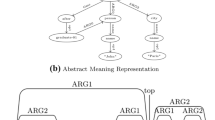Abstract
The paper argues that Guarino is right that ontologies are different from thesauri and similar objects, but not in the ways he believes: they are distinguished from essentially linguistic objects like thesauri and hierarchies of conceptual relations because they unpack, ultimately, in terms of sets of objects and individuals. However this is a lonely status, and without much application outside strict scientific and engineering disciplines, and of no direct relevance to language processing (NLP). More interesting structures, of NLP relevance, that encode conceptual knowledge, cannot be subjected to the “cleaning up” techniques that Guarino advocates, because his conditions are too strict to be applicable, and because the terms used in such structures retain their language-like features of ambiguity and vagueness, and in a way that cannot be eliminated by reference to sets of objects, as it can be in ontologies in the narrow sense. Wordnet is a structure that remains useful to NLP, and has within it features of both types (ontologies and conceptual hierarchies) and its function and usefulness will remain, properly, resistant to Guarino’s techniques, because those rest on a misunderstanding about concepts. The ultimate way out of such disputes can only come from automatic construction and evaluation procedures for conceptual and ontological structures from data, which is to say, corpora.
Similar content being viewed by others
References
Bergson, H. (1900/1924). Le rire: essai sur la signification du comique. Paris: Editions Alcan.
Bosanquet, R. (1946). Remarks on Spinoza’s ethics. Mind, 55.
Braithwaite, R. (1953). Scientific explanation. Cambridge: Cambridge University Press.
Brewster, C., Iria, J., Ciravegna, F., & Wilks, Y. (2005). The ontology: Chimaera or Pegasus. In Proc. Dagstuhl seminar machine learning for the semantic web.
Carnap, R. (1946). Semantics and necessity. Chicago: University of Chicago Press.
Gangemi, A., Guarino, N., & Oltramari, A. (2001). Conceptual analysis of lexical taxonomies: The case of WordNet top-level. In Proc. of FOIS2001.
Hirst, G. (2004). Ontology and the lexicon. In Staab & Studer (Eds.), Handbook on ontologies. Berlin: Springer.
Hobbs, J. (1983). Ontological promiscuity. In Proc. 23rd annual meeting of the assn. comp. ling.
Horrocks, I., Patel-Schneider, P., & van Harmelen, F. (2002). Reviewing the design of DAML+OIL: An ontology language for the semantic web. In Proc. of the 18th nat. conf. on artificial intelligence (AAAI’02). Menlo Park: AAAI Press.
Hovy, E. (1998). Combining and standardizing large-scale, practical, ontologies for machine translation and other uses. In Proc. 1st international conf. on languages, resources and evaluation, Granada, Spain.
Hovy, E., & Nirenburg, S. (1992). Approximating and Interlingua in a principled way. In Proc. DARPA speech and language workshop, Hawthorne, NY.
Katz, J. (1972). Semantic theory. New York: Harper and Row.
Lenat, D. (1995). CyC: a large scale investment in knowledge infrastructure. Communications of the ACM, 38.
Mahesh, K., Nirenburg, S., & Beale (2000). Toward full-text ontology-based word sense disambiguation. In Nicolov & Mitkov (Eds.), Recent advances in natural language processing II. Amsterdam: Benjamins.
Masterman, M. (2005). Language, cohesion and form: selected papers of Margaret Masterman. In Wilks (Ed.), Cambridge: Cambridge University Press.
McDermott, D. (1976). Artificial intelligence meets natural stupidity. Reprinted in Haugeland (Ed.) (1981), Mind design. Cambridge: Bradford Books/MIT Press.
Miller, G. (1995). Wordnet: a lexical database for English. Communications of the ACM, 38.
Morgan, A., Hirschmann, L., Yeh, A., & Colosimo, M. (2003). Gene name extraction using FlyBase resources. In ACL workshop on language processing in biomedicine, Sapporo, Japan.
Nirenburg, S., & Wilks, Y. (2001). What’s in a symbol: ontology, representation and language. Journal of Experimental and Theoretical Artificial Intelligence (JETAI).
Olney, J., Revard, C., & Ziff, P. (1966). Some monsters in Noah’s ark (Research Memorandum). Systems Development Corp., Santa Monica, CA.
Oltramari, A., Gangemi, A., Guarino, N., & Masolo, C. (2002). Restructuring WordNet’s top-level: the OntoClean approach. In Proc. LREC02, Spain.
Peters, W. (2001). An exploration of figurative language use in WordNet. In Proc. corpus linguistics 2001, University of Birmingham.
Pollack, J. B. (1990). Recursive distributed representations. Artificial Intelligence, 46(1).
Pustejovsky, J. (2001). Type construction and the logic of concepts. In Bouillon & Busa (Eds.), The syntax of word meaning. Cambridge: Cambridge University Press.
Putnam, H. (1970). Is semantics possible? Metaphilosophy.
Quine, W. V. O. (1951). Two dogmas of empiricism. The Philosophical Review.
Schvaneveldt, R. W., Durso, F. T., Goldsmith, T. E., Breen, T. J., Cooke, N. M., Tucker, R. G., & DeMaio, J. C. (1985). Measuring the structure of expertise. International Journal of Man-Machine Studies, 23.
Smith, B. (1995). Formal ontology, common sense and cognitive science. International Journal on Human-Computer Studies, 43, 5–6.
Sowa, J. (2004). The challenge of knowledge soup. In Proc. first international WordNet conference, Goa, India.
Wilks, Y. (1968). Argument and proof in metaphysics, from an empirical point of view. Unpublished PhD thesis (advisor: Professor R.B. Braithwaite), University of Cambridge.
Wilks, Y. (1994). Stone Soup and the French room: the empiricist-rationalist debate about machine translation. In Zampolli, Calzolari, & Palmer (Eds.), Current issues in computational linguistics: in honor of Don Walker. Berlin: Kluwer.
Wilks, Y., Slator, B., & Guthrie, L. (1996). Electric words: dictionaries, computers and meanings. Cambridge: MIT Press.
Woods, W. (1975). What’s in a link: foundations for semantic networks. In Bobrow & Collins (Eds.), Representation and understanding: studies in cognitive science. New York: Academic Press.
Author information
Authors and Affiliations
Corresponding author
Rights and permissions
About this article
Cite this article
Wilks, Y. Wordnet as a resource for NLP: Yorick Wilks’ reflections on the ontological debate—and how to cope with ambiguity and vagueness of natural language. Int J Speech Technol 11, 109 (2008). https://doi.org/10.1007/s10772-009-9045-5
Received:
Accepted:
Published:
DOI: https://doi.org/10.1007/s10772-009-9045-5




